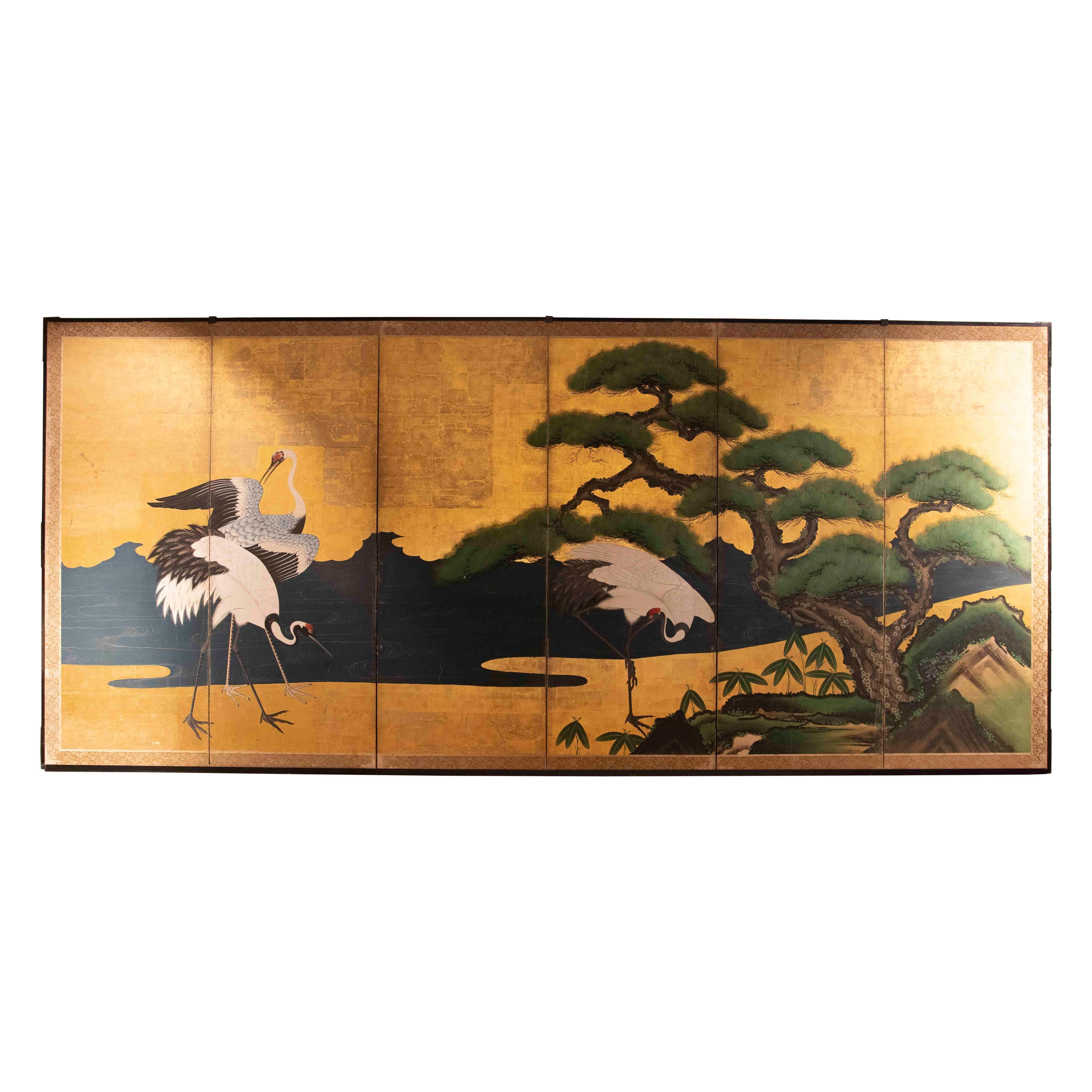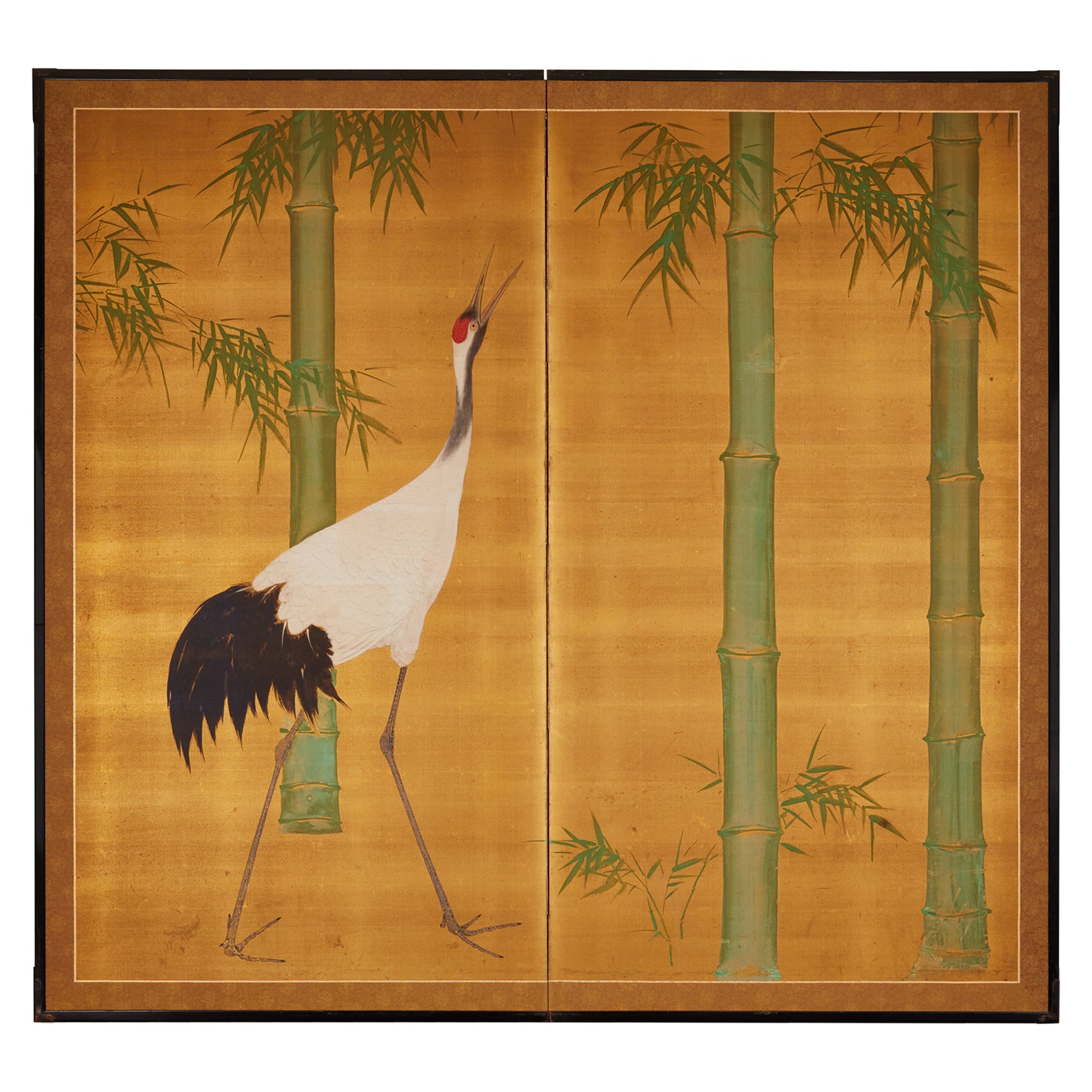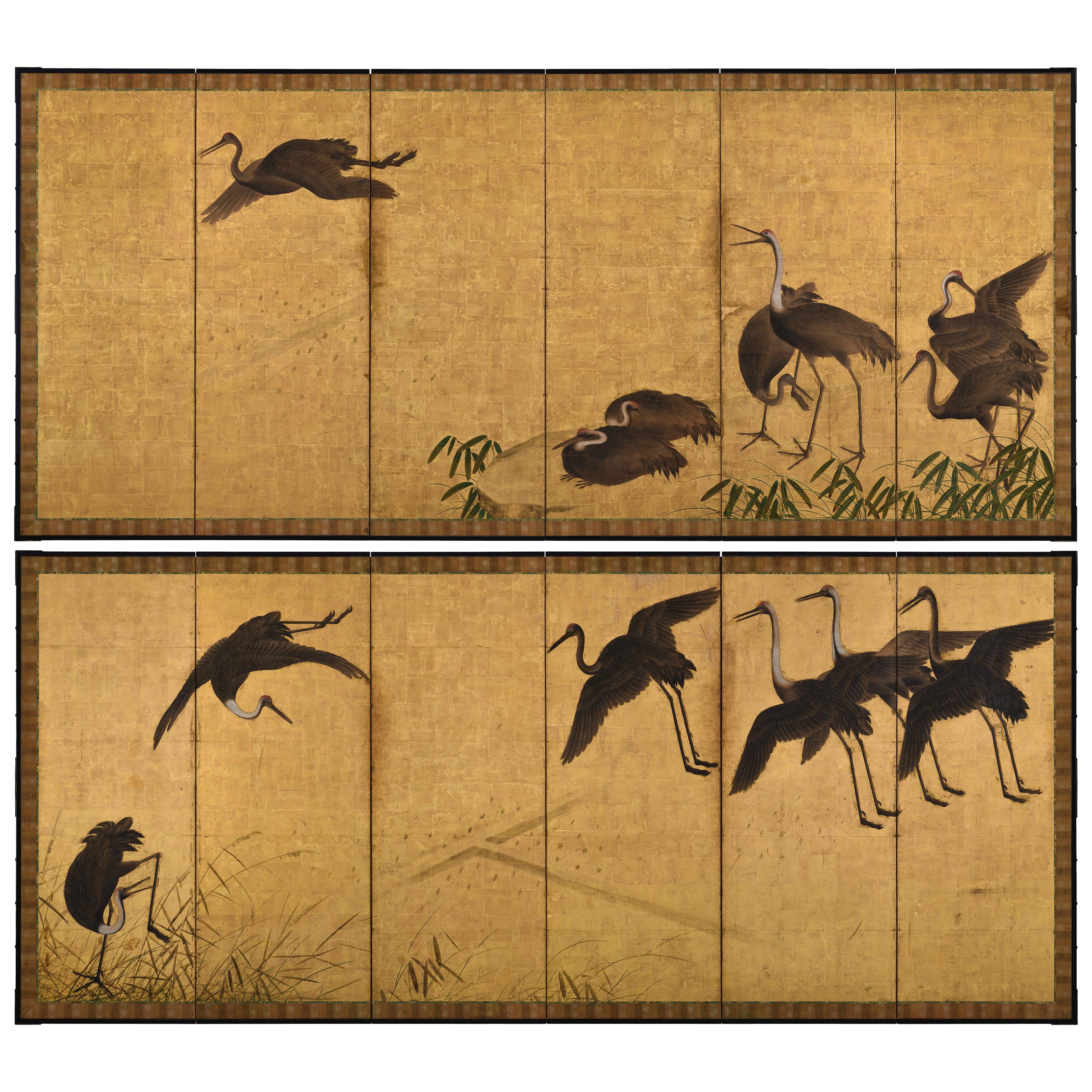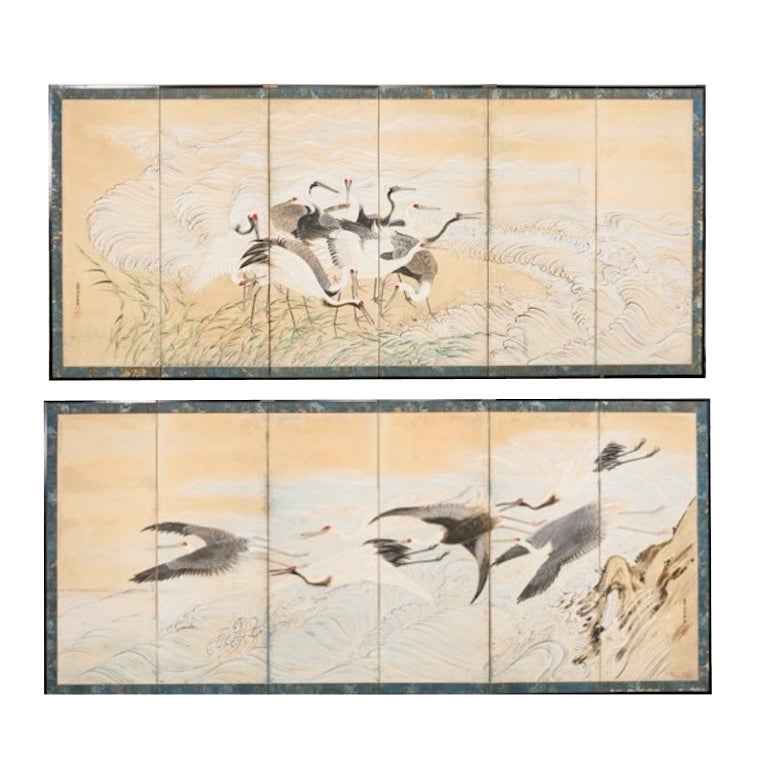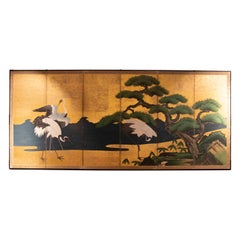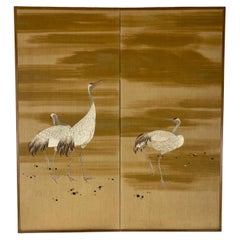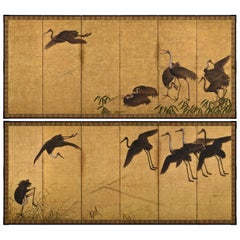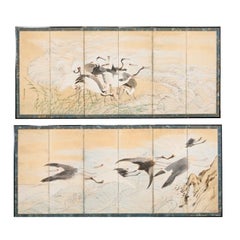Items Similar to Japanese Two-Panel Screen: Cranes on Gold
Want more images or videos?
Request additional images or videos from the seller
1 of 11
Japanese Two-Panel Screen: Cranes on Gold
$40,250
£30,415.60
€35,122.55
CA$56,243.30
A$62,406.68
CHF 32,689.96
MX$765,273.41
NOK 415,805.04
SEK 392,502.22
DKK 261,930.90
Shipping
Retrieving quote...The 1stDibs Promise:
Authenticity Guarantee,
Money-Back Guarantee,
24-Hour Cancellation
About the Item
Early Kano School painting of pine trees overlooking two beautifully painted cranes and floral design in a natural setting by water’s edge. Mineral pigments, gold dust and gold leaf on mulberry paper. With a gold embroidered 17th century silk brocade border and black lacquer trim. Wonderfully preserved.
- Dimensions:Height: 66 in (167.64 cm)Width: 73 in (185.42 cm)Depth: 0.75 in (1.91 cm)
- Materials and Techniques:
- Place of Origin:
- Period:
- Date of Manufacture:circa 1780
- Condition:Condition report upon request.
- Seller Location:Hudson, NY
- Reference Number:Seller: S18941stDibs: LU855131778242
About the Seller
5.0
Recognized Seller
These prestigious sellers are industry leaders and represent the highest echelon for item quality and design.
Established in 1971
1stDibs seller since 2008
166 sales on 1stDibs
Typical response time: 21 hours
Associations
The Art and Antique Dealers League of AmericaAntiques Associations Members
- ShippingRetrieving quote...Shipping from: Hudson, NY
- Return Policy
Authenticity Guarantee
In the unlikely event there’s an issue with an item’s authenticity, contact us within 1 year for a full refund. DetailsMoney-Back Guarantee
If your item is not as described, is damaged in transit, or does not arrive, contact us within 7 days for a full refund. Details24-Hour Cancellation
You have a 24-hour grace period in which to reconsider your purchase, with no questions asked.Vetted Professional Sellers
Our world-class sellers must adhere to strict standards for service and quality, maintaining the integrity of our listings.Price-Match Guarantee
If you find that a seller listed the same item for a lower price elsewhere, we’ll match it.Trusted Global Delivery
Our best-in-class carrier network provides specialized shipping options worldwide, including custom delivery.More From This Seller
View AllJapanese Two Panel Screen: Bamboo and Manchurian Crane
Located in Hudson, NY
Kano style painting in mineral pigments on silk with a silk brocade border.
Category
Early 20th Century Japanese Paintings and Screens
Materials
Brocade, Silk
Japanese Two Panel Screen Amorous Cranes and Turtles
Located in Hudson, NY
Japanese two panel screen: Amorous Cranes and Turtles. In Japan, cranes symbolize fidelity as they mate for life and turtles symbolize longevity. Additionally, this screen also has the Japanese motif of sho-chiku-bai, or the three friends of winter (pine, plum, and bamboo). So called the three friends of winter because all three flourish during the cold months. This screen was originally fusuma doors...
Category
Antique 1850s Japanese Edo Paintings and Screens
Materials
Wood, Paper
Japanese Two Panel Screen Manchurian Crane and Turtles
Located in Hudson, NY
In Japan, cranes symbolize fidelity as they mate for life and turtles symbolize longevity. Additionally, this screen also has the Japanese motif of sho-chiku-bai, or the three friends of winter (pine, plum, and bamboo). So called the three friends of winter because all three flourish during the cold months. This screen was originally fusuma doors...
Category
Antique Mid-19th Century Japanese Edo Paintings and Screens
Materials
Paper
Japanese Two Panel Screen, Lotus and Heron
Located in Hudson, NY
Japanese two panel screen, lotus and heron
Colored mineral pigments on silver leaf on handmade mulberry paper.
Category
Antique Late 19th Century Japanese Paintings and Screens
Japanese Two-Panel Screen: Geese in a Country Setting
Located in Hudson, NY
Country farm geese with early spring blossoms and a bamboo fence. Beautiful details on the feathers. Signature and seal read Keibo Joshi (Ms. Keibo) min...
Category
Early 20th Century Japanese Meiji Paintings and Screens
Materials
Silk, Wood, Paper
Japanese Six Panel Screen, Egrets in Water Landscape with Lotus and Loquats
Located in Hudson, NY
Hasegawa School painting in ink and gold dust accents on mulberry paper.
Category
Antique Mid-19th Century Japanese Paintings and Screens
Materials
Gold
You May Also Like
19th Japanese Screen with Cranes and Pine on a Golden Background
Located in Marbella, ES
Stunning four-panel Japanese screen decorated with a traditional scene of cranes and a majestic pine tree on a gold background. The painting technique highlights the details of the b...
Category
Antique 19th Century Japanese Paintings and Screens
Materials
Gold, Iron
Asian Folding Hand Woven Screen of Cranes
Located in Denton, TX
Asian Folding Hand Woven 2 Panel Screen of Cranes.
Category
Mid-20th Century Japanese Anglo-Japanese Tapestries
Materials
Thread
$1,575 Sale Price
30% Off
17th Century Japanese Screen Pair. Flock of Cranes. Ink and color on gold leaf.
Located in Kyoto, JP
A pair of six-fold Japanese screens from the 17th century depicting a flock of cranes arriving at their wintering grounds. The expansive scene is heavily atmospheric. The cranes are...
Category
Antique 17th Century Japanese Edo Paintings and Screens
Materials
Gold Leaf
Pair of Japanese Meiji Six Panel Screen Cranes Above Cresting Waves
Located in Rio Vista, CA
Amazing 19th century pair of large Japanese Meiji period six panel screens each depicting a sedge of Manchurian red-crowned cranes along the shore. The screens are crafted in the Nihonga school style with intricate details and beautifully depicted cresting waves. Each screen is signed by artist Hakundo Keikan and studio name of Watahiki Tokai (Japanese 1837-1915). Both screens are signed with red seals on the left and right side. Tokai was a Chinese scholar from the late Edo period and served in the Imperial Household...
Category
Antique 19th Century Japanese Meiji Paintings and Screens
Materials
Brass
17th Century Japanese Screen. Cranes and Peonies. Edo period.
Located in Kyoto, JP
Cranes and Peonies
Anonymous, Kano School.
Edo period, second half of the 17th century.
Six-panel Japanese screen. Ink, pigment gofun and gold leaf on paper.
This Japanese screen...
Category
Antique Mid-17th Century Japanese Edo Paintings and Screens
Materials
Gold Leaf
Chinese Export Four Panel Coromandel Screen Cranes on Gold Leaf
Located in Rio Vista, CA
Dazzling Chinese export lacquered four-panel coromandel screen featuring a flora and fauna waterscape with stylized cranes. The carved lacquer panels...
Category
20th Century Chinese Chinese Export Paintings and Screens
Materials
Brass, Gold Leaf
More Ways To Browse
Painted Panel Screen
Floral Screen
Antique Crane
Two Cranes
Antique Embroidered Gold
Japanese Lacquer Panels
Antique Japanese Silk Screen
Japanese Silk Brocade
Gold Cranes
Japanese Antique Gold Screen
Wood Crane
Crane Panel
Japanese Crane Art
Japanese Gold Leaf Panel Paintings
Japanese Painting Silk Gold
Japanese Art Of Cranes
Antique Gold Leaf Screens
Japanese Screen Gold Leaf
